Yuxin Li
May
Step-Audio 2 Technical Report
Jul 24, 2025Abstract:This paper presents Step-Audio 2, an end-to-end multi-modal large language model designed for industry-strength audio understanding and speech conversation. By integrating a latent audio encoder and reasoning-centric reinforcement learning (RL), Step-Audio 2 achieves promising performance in automatic speech recognition (ASR) and audio understanding. To facilitate genuine end-to-end speech conversation, Step-Audio 2 incorporates the generation of discrete audio tokens into language modeling, significantly enhancing its responsiveness to paralinguistic information such as speaking styles and emotions. To effectively leverage the rich textual and acoustic knowledge in real-world data, Step-Audio 2 integrates retrieval-augmented generation (RAG) and is able to call external tools such as web search to mitigate hallucination and audio search to switch timbres. Trained on millions of hours of speech and audio data, Step-Audio 2 delivers intelligence and expressiveness across diverse conversational scenarios. Evaluation results demonstrate that Step-Audio 2 achieves state-of-the-art performance on various audio understanding and conversational benchmarks compared to other open-source and commercial solutions. Please visit https://github.com/stepfun-ai/Step-Audio2 for more information.
Let's Reason Formally: Natural-Formal Hybrid Reasoning Enhances LLM's Math Capability
May 29, 2025Abstract:Enhancing the mathematical reasoning capabilities of LLMs has garnered significant attention in both the mathematical and computer science communities. Recent works have made substantial progress in both Natural Language (NL) reasoning and Formal Language (FL) reasoning by leveraging the potential of pure Reinforcement Learning (RL) methods on base models. However, RL approaches struggle to impart new capabilities not presented in the base model, highlighting the need to integrate more knowledge like FL into NL math reasoning effectively. Yet, this integration is challenging due to inherent disparities in problem structure and reasoning format between NL and FL. To address these challenges, we introduce **NL-FL HybridReasoning**, an end-to-end framework designed to incorporate the FL expert into NL math problem-solving. To bridge the NL and FL input format gap, we propose the *NL-FL Problem Alignment* method, which reformulates the Question-Answering (QA) problems in NL as existence theorems in FL. Subsequently, the *Mixed Problem Input* technique we provide enables the FL reasoner to handle both QA and existence problems concurrently. Lastly, we mitigate the NL and FL output format gap in reasoning through an LLM-based *Answer Extraction* mechanism. Comprehensive experiments demonstrate that the **HybridReasoning** framework achieves **89.80%** and **84.34%** accuracy rates on the MATH-500 and the AMC benchmarks, surpassing the NL baseline by 4.60% and 4.82%, respectively. Notably, some problems resolved by our framework remain unsolved by the NL baseline model even under a larger number of trials.
MA-LoT: Multi-Agent Lean-based Long Chain-of-Thought Reasoning enhances Formal Theorem Proving
Mar 05, 2025



Abstract:Solving mathematical problems using computer-verifiable languages like Lean has significantly impacted mathematical and computer science communities. State-of-the-art methods utilize single Large Language Models (LLMs) as agents or provers to either generate complete proof or perform tree searches. However, single-agent methods inherently lack a structured way to combine high-level reasoning in Natural Language (NL) with Formal Language (FL) verification feedback. To solve these issues, we propose MA-LoT: Multi-Agent Lean-based Long Chain-of-Thought framework, (to the best of our knowledge), the first multi-agent framework for Lean4 theorem proving that balance high-level NL reasoning and FL verification in Long CoT. Using this structured interaction, our approach enables deeper insights and long-term coherence in proof generation, with which past methods struggle. We do this by leveraging emergent formal reasoning ability in Long CoT using our novel LoT-Transfer Learning training-inference pipeline. Extensive experiments show that our framework achieves 54.51% accuracy rate on the Lean4 version of MiniF2F-Test dataset, largely outperforming GPT-4 (22.95%), single-agent tree search (InternLM-Step-Prover, 50.70%), and whole-proof generation (DeepSeek-Prover-v1.5, 48.36%) baselines. Furthermore, our findings highlight the potential of combining Long CoT with formal verification for a more insightful generation in a broader perspective.
Enhancing Subject-Independent Accuracy in fNIRS-based Brain-Computer Interfaces with Optimized Channel Selection
Feb 26, 2025Abstract:Achieving high subject-independent accuracy in functional near-infrared spectroscopy (fNIRS)-based brain-computer interfaces (BCIs) remains a challenge, particularly when minimizing the number of channels. This study proposes a novel feature extraction scheme and a Pearson correlation-based channel selection algorithm to enhance classification accuracy while reducing hardware complexity. Using an open-access fNIRS dataset, our method improved average accuracy by 28.09% compared to existing approaches, achieving a peak subject-independent accuracy of 95.98% with only two channels. These results demonstrate the potential of our optimized feature extraction and channel selection methods for developing efficient, subject-independent fNIRS-based BCI systems.
Bridging Jensen Gap for Max-Min Group Fairness Optimization in Recommendation
Feb 13, 2025Abstract:Group max-min fairness (MMF) is commonly used in fairness-aware recommender systems (RS) as an optimization objective, as it aims to protect marginalized item groups and ensures a fair competition platform. However, our theoretical analysis indicates that integrating MMF constraint violates the assumption of sample independence during optimization, causing the loss function to deviate from linear additivity. Such nonlinearity property introduces the Jensen gap between the model's convergence point and the optimal point if mini-batch sampling is applied. Both theoretical and empirical studies show that as the mini-batch size decreases and the group size increases, the Jensen gap will widen accordingly. Some methods using heuristic re-weighting or debiasing strategies have the potential to bridge the Jensen gap. However, they either lack theoretical guarantees or suffer from heavy computational costs. To overcome these limitations, we first theoretically demonstrate that the MMF-constrained objective can be essentially reformulated as a group-weighted optimization objective. Then we present an efficient and effective algorithm named FairDual, which utilizes a dual optimization technique to minimize the Jensen gap. Our theoretical analysis demonstrates that FairDual can achieve a sub-linear convergence rate to the globally optimal solution and the Jensen gap can be well bounded under a mini-batch sampling strategy with random shuffle. Extensive experiments conducted using six large-scale RS backbone models on three publicly available datasets demonstrate that FairDual outperforms all baselines in terms of both accuracy and fairness. Our data and codes are shared at https://github.com/XuChen0427/FairDual.
QuadBEV: An Efficient Quadruple-Task Perception Framework via Bird's-Eye-View Representation
Oct 09, 2024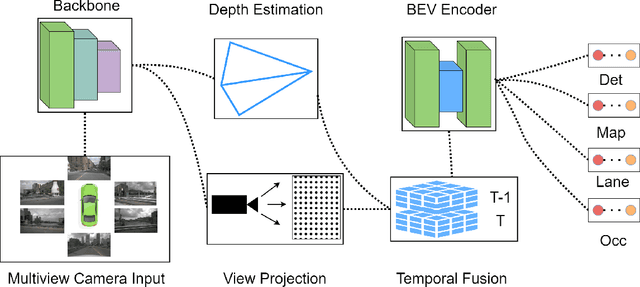
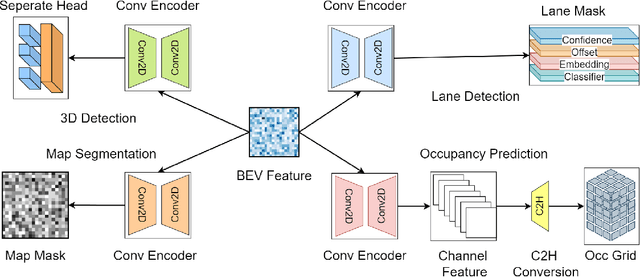
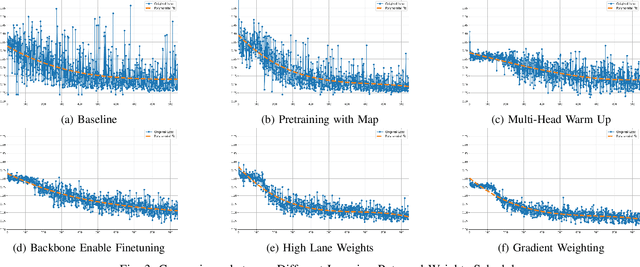

Abstract:Bird's-Eye-View (BEV) perception has become a vital component of autonomous driving systems due to its ability to integrate multiple sensor inputs into a unified representation, enhancing performance in various downstream tasks. However, the computational demands of BEV models pose challenges for real-world deployment in vehicles with limited resources. To address these limitations, we propose QuadBEV, an efficient multitask perception framework that leverages the shared spatial and contextual information across four key tasks: 3D object detection, lane detection, map segmentation, and occupancy prediction. QuadBEV not only streamlines the integration of these tasks using a shared backbone and task-specific heads but also addresses common multitask learning challenges such as learning rate sensitivity and conflicting task objectives. Our framework reduces redundant computations, thereby enhancing system efficiency, making it particularly suited for embedded systems. We present comprehensive experiments that validate the effectiveness and robustness of QuadBEV, demonstrating its suitability for real-world applications.
Learning Content-Aware Multi-Modal Joint Input Pruning via Bird's-Eye-View Representation
Oct 09, 2024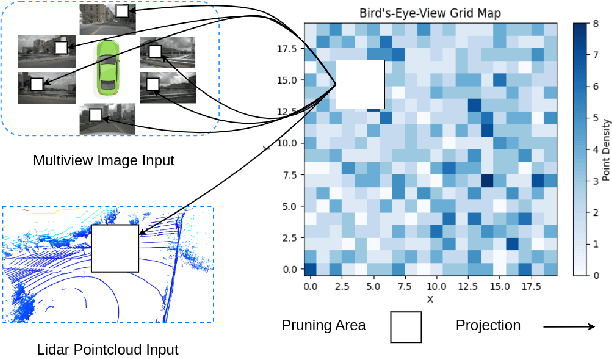
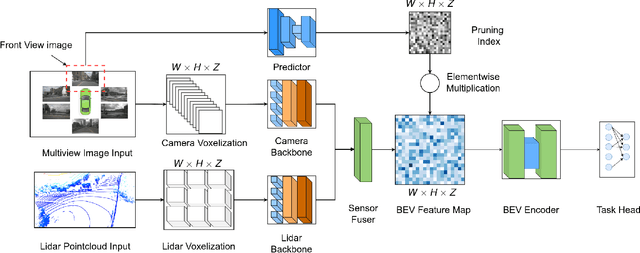
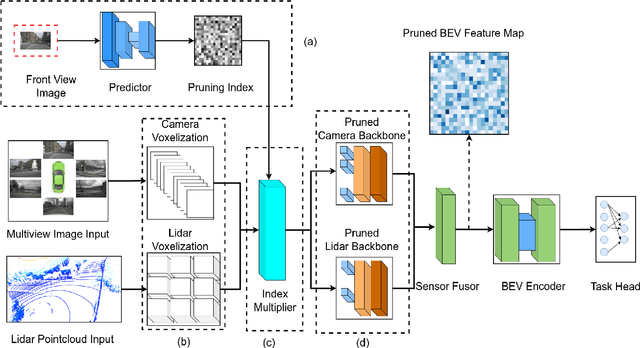
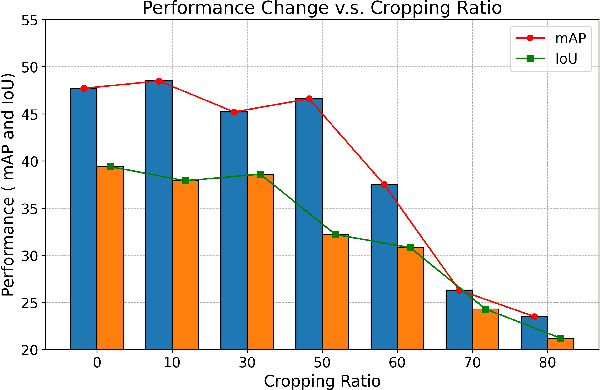
Abstract:In the landscape of autonomous driving, Bird's-Eye-View (BEV) representation has recently garnered substantial academic attention, serving as a transformative framework for the fusion of multi-modal sensor inputs. This BEV paradigm effectively shifts the sensor fusion challenge from a rule-based methodology to a data-centric approach, thereby facilitating more nuanced feature extraction from an array of heterogeneous sensors. Notwithstanding its evident merits, the computational overhead associated with BEV-based techniques often mandates high-capacity hardware infrastructures, thus posing challenges for practical, real-world implementations. To mitigate this limitation, we introduce a novel content-aware multi-modal joint input pruning technique. Our method leverages BEV as a shared anchor to algorithmically identify and eliminate non-essential sensor regions prior to their introduction into the perception model's backbone. We validatethe efficacy of our approach through extensive experiments on the NuScenes dataset, demonstrating substantial computational efficiency without sacrificing perception accuracy. To the best of our knowledge, this work represents the first attempt to alleviate the computational burden from the input pruning point.
Technical Report of HelixFold3 for Biomolecular Structure Prediction
Aug 30, 2024



Abstract:The AlphaFold series has transformed protein structure prediction with remarkable accuracy, often matching experimental methods. AlphaFold2, AlphaFold-Multimer, and the latest AlphaFold3 represent significant strides in predicting single protein chains, protein complexes, and biomolecular structures. While AlphaFold2 and AlphaFold-Multimer are open-sourced, facilitating rapid and reliable predictions, AlphaFold3 remains partially accessible through a limited online server and has not been open-sourced, restricting further development. To address these challenges, the PaddleHelix team is developing HelixFold3, aiming to replicate AlphaFold3's capabilities. Using insights from previous models and extensive datasets, HelixFold3 achieves an accuracy comparable to AlphaFold3 in predicting the structures of conventional ligands, nucleic acids, and proteins. The initial release of HelixFold3 is available as open source on GitHub for academic research, promising to advance biomolecular research and accelerate discoveries. We also provide online service at PaddleHelix website at https://paddlehelix.baidu.com/app/all/helixfold3/forecast.
Disentangled Generative Graph Representation Learning
Aug 24, 2024Abstract:Recently, generative graph models have shown promising results in learning graph representations through self-supervised methods. However, most existing generative graph representation learning (GRL) approaches rely on random masking across the entire graph, which overlooks the entanglement of learned representations. This oversight results in non-robustness and a lack of explainability. Furthermore, disentangling the learned representations remains a significant challenge and has not been sufficiently explored in GRL research. Based on these insights, this paper introduces DiGGR (Disentangled Generative Graph Representation Learning), a self-supervised learning framework. DiGGR aims to learn latent disentangled factors and utilizes them to guide graph mask modeling, thereby enhancing the disentanglement of learned representations and enabling end-to-end joint learning. Extensive experiments on 11 public datasets for two different graph learning tasks demonstrate that DiGGR consistently outperforms many previous self-supervised methods, verifying the effectiveness of the proposed approach.
3D Gaussian Splatting: Survey, Technologies, Challenges, and Opportunities
Jul 24, 2024



Abstract:3D Gaussian Splatting (3DGS) has emerged as a prominent technique with the potential to become a mainstream method for 3D representations. It can effectively transform multi-view images into explicit 3D Gaussian representations through efficient training, and achieve real-time rendering of novel views. This survey aims to analyze existing 3DGS-related works from multiple intersecting perspectives, including related tasks, technologies, challenges, and opportunities. The primary objective is to provide newcomers with a rapid understanding of the field and to assist researchers in methodically organizing existing technologies and challenges. Specifically, we delve into the optimization, application, and extension of 3DGS, categorizing them based on their focuses or motivations. Additionally, we summarize and classify nine types of technical modules and corresponding improvements identified in existing works. Based on these analyses, we further examine the common challenges and technologies across various tasks, proposing potential research opportunities.
 Add to Chrome
Add to Chrome Add to Firefox
Add to Firefox Add to Edge
Add to Edge